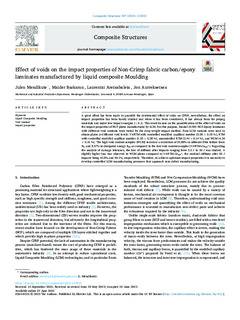| dc.rights.license | Attribution 4.0 International | * |
| dc.contributor.author | Mendikute, Julen | |
| dc.contributor.author | Baskaran, Maider | |
| dc.contributor.author | Aretxabaleta, Laurentzi | |
| dc.contributor.author | Aurrekoetxea, Jon | |
| dc.date.accessioned | 2023-03-02T11:21:00Z | |
| dc.date.available | 2023-03-02T11:21:00Z | |
| dc.date.issued | 2022 | |
| dc.identifier.issn | 0263-8223 | en |
| dc.identifier.other | https://katalogoa.mondragon.edu/janium-bin/janium_login_opac.pl?find&ficha_no=168090 | en |
| dc.identifier.uri | https://hdl.handle.net/20.500.11984/6027 | |
| dc.description.abstract | A great effort has been made to quantify the detrimental effect of voids on CFRP, nevertheless, the effect on impact properties has been barely studied and when it has been considered, it has always been for prepeg materials and under low impact energies (< 6 J). This work focuses on the quantification of the effect of voids on the impact properties of NCF plates manufactured by LCM. For this purpose, biaxial (0/90) NCF-Epoxy laminates with different void contents were tested by the drop weight impact method. Four LCM variants were used to obtain plates at different void levels: VARTM with controlled modified capillary number (0.58 ± 0.18 %), RTM with controlled modified capillary number (1.35 ± 0.28 %), uncontrolled RTM (2.44 ± 0.14 %), and WCM (4.34 ± 0.31 %). The high void content samples (WCM) recorded a reduction of 25.88% in ultimate fibre failure force Fff, and 9.57% in dissipated energy Edis as compared to the low void content samples (VARTM-Caopt*). Regarding the analysis of damage tolerance, the loss of stiffness after impacts ranging from 2.5 J to 20 J was studied. A slightly higher loss was observed in WCM plates compared to VARTM-Caopt*, the residual stiffness after 20 J impacts being 45.8% and 49.1%, respectively. Therefore, to achieve optimum impact properties it is necessity to develop controlled LCM manufacturing processes that approach zero-defect manufacturing. | en |
| dc.description.sponsorship | Gobierno Vasco-Eusko Jaurlaritza | es |
| dc.language.iso | eng | en |
| dc.publisher | Elsevier | en |
| dc.rights | © 2023 The Authors | en |
| dc.rights.uri | http://creativecommons.org/licenses/by/4.0/ | * |
| dc.subject | Liquid Composite Moulding | en |
| dc.subject | Void content | en |
| dc.subject | Impact properties | en |
| dc.title | Effect of voids on the impact properties of Non-Crimp fabric carbon/epoxy laminates manufactured by liquid composite Moulding | en |
| dcterms.accessRights | http://purl.org/coar/access_right/c_abf2 | en |
| dcterms.source | Composite Structures | en |
| local.contributor.group | Tecnología de plásticos y compuestos | es |
| local.description.peerreviewed | true | en |
| local.identifier.doi | https://doi.org/10.1016/j.compstruct.2022.115922 | en |
| local.relation.projectID | info:eu-repo/grantAgreement/GV/Programa predoctoral de formación del personal investigador no doctor 2018-2019/PRE_2018_1_0338/CAPV | en |
| local.relation.projectID | info:eu-repo/grantAgreement/GV/Ikertalde Convocatoria/IT833-16 | en |
| local.relation.projectID | info:eu-repo/grantAgreement/GV/Elkartek 2018/KK-2017-00062/CAPV/Composites para automoción fabricados mediante RTM adaptada a filosofía Industry 4.0/RTM4.0 | en |
| local.source.details | Vol. 297. Artículo 115922 | en |
| oaire.format.mimetype | application/pdf | |
| oaire.file | $DSPACE\assetstore | |
| oaire.resourceType | http://purl.org/coar/resource_type/c_6501 | en |
| oaire.version | http://purl.org/coar/version/c_970fb48d4fbd8a85 | en |








